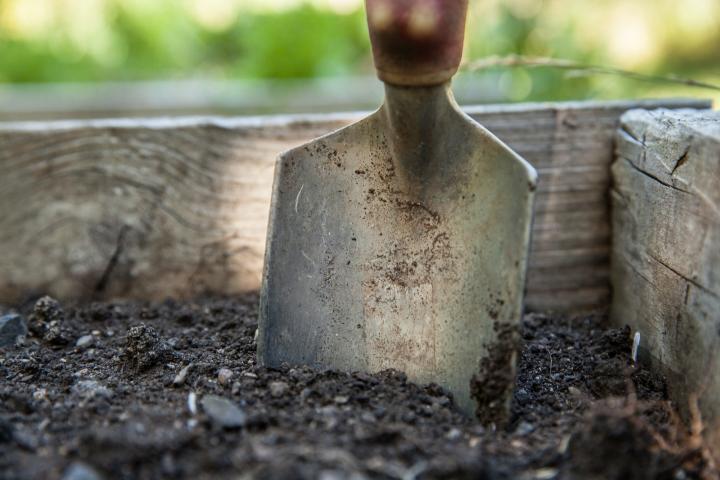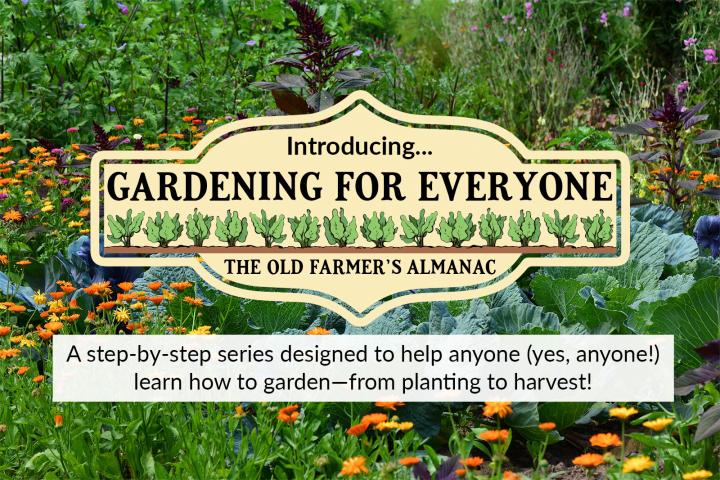Pelajari Semua Tentang Menggunakan Pupuk di Kebun
Kami menggunakan pupuk untuk membuat tanaman kami tumbuh lebih baik, tetapi kapan waktu terbaik untuk menggunakan pupuk? Dan berapa banyak jenis pupuk apa yang kita terapkan? Dalam satu halaman, kami akan membahas dasar-dasar penggunaan pupuk di kebun Anda.
Apa itu pupuk?
Selain memiliki tanah yang kaya akan bahan organik (kompos!), tanaman seringkali membutuhkan aplikasi pupuk untuk mendapatkan nutrisi yang dibutuhkan. Pikirkan pupuk sebagai suplemen nutrisi. Misalnya, tomat perlu tumbuh di tanah yang memiliki banyak kalsium.
Jika Anda telah menanam dan memanen tanaman di kebun Anda di masa lalu, tanaman ini mengambil nutrisi dari tanah, dan nutrisi tersebut harus diganti di musim semi sebelum lebih banyak tanaman ditanam di sana. Di sinilah pupuk (organik atau olahan) berperan. Pupuk menggantikan nutrisi yang hilang, yang memastikan bahwa tingkat nutrisi tanah berada pada tingkat yang dapat diterima untuk pertumbuhan yang sehat.
Jika Anda seorang tukang kebun baru, langkah pertama yang ideal adalah mendapatkan tes tanah dasar di musim gugur untuk melihat jenis dan jumlah pupuk apa yang akan diterapkan untuk mencapai tingkat "kesuburan dasar". (Lihat lebih lanjut tentang pengujian di bawah ini.) Kami menyadari bahwa tidak setiap tukang kebun meluangkan waktu untuk melakukan tes tanah, tetapi kami merekomendasikannya; Anda bahkan mungkin menemukan bahwa tingkat kesuburan kebun Anda sudah memadai.
Oleskan pupuk dengan hati-hati: Satu-satunya hal yang lebih buruk daripada membuat tanaman nutrisi kelaparan adalah secara tidak sengaja melebih-lebihkannya. Tanaman hanya menggunakan nutrisi yang mereka butuhkan. Menyerap lebih dari yang diperlukan dapat mengakibatkan pertumbuhan abnormal atau efek samping.
Kapan Harus Menyuburkan Kebun Anda
Untuk tanaman yang dapat dimakan, pupuk biasanya diterapkan di musim semi dan dicampur ke dalam tanah kebun sebelum ditanam. Jika Anda sudah menabur benih atau menanam bibit, Anda masih bisa bekerja dengan lembut dalam pupuk granular (bukan pupuk cair, yang dapat membakar akar muda) di sekitar tanaman. Itu tidak perlu dikerjakan jauh ke dalam tanah — 3 hingga 5 inci bagian atas akan berhasil. Kemudian siram dalam pupuk.
For perennial flowering plants, fertilize before growth begins in the spring. Wait until the ground is no longer frozen and the date of your last frost is only a week or so away. This ensures that there is less of a chance of the tender new growth brought about by the fertilizer getting immediately killed by frost.
While a spring application is a good general rule, understand that what plants really need is help when they are growing the most.
- This occurs earlier for spring plantings of lettuce, arugula, kale, and other leafy greens.
- Rapid growth occurs in midsummer for corn and squash. So, for a long-season crop such as corn, many gardeners apply a small amount of fertilizer as a starter at the time of seeding, and then also add a larger amount in early summer, just before the period of rapid foliar growth.
- Tomatoes and potatoes will need extra fertilizer mid-season as the plants take up and use existing nutrients. When tomatoes start producing flowers, switch to a low-nitrogen fertilizer in order to encourage more flowers and fruit rather than foliage.
- For perennial plants, the timing depends on the plant’s growth cycle. Blueberries, for example, benefit when fertilizer is applied early in the season at bud break, while June-bearing strawberries benefit most when fertilized after the harvest.
- Ornamental trees, shrubs, and perennials are often fertilized at the beginning of their growing season, as dormancy breaks.

Always Take a Soil Test!
The only way to truly determine the level of nutrients in your soil is a “soil test.” Testing in autumn will give you plenty of time to receive the results. Soil tests are usually available for free or low-cost from your local cooperative extension. You will not need to do this ever year. The goal is to understand your soil, build it up, and then simply apply fertilizer to the soil ever year to maintain the basic fertility level.
You may even find that if your garden has been fertilized for years, you have high levels of nutrients. You do not want to add nutrients to your soil if it’s already available in high amounts; this may actually inhibit your plants’ growth. Read more about how to take a soil test.
How Much of What Kind of Fertilizer Should I Use?
A fertilizer bag will be labeled with a combination of numbers such as 3-4-4 or 8-24-8, or 12-12-12. These three numbers refer to the three most important nutrients plants need: Nitrogen (N), Phosphorus (P), and Potassium (K). The numbers refer to the percentage of weight of each nutrient in the bag. If you add up the numbers, they are the percentage of the bag’s total weight (the rest is simply filler to make it easy to apply). There may also be other nutrients, including calcium, magnesium, iron, and manganese.
To start your garden, use a general vegetable fertilizer. For vegetables, we use an herb and vegetable plant food with a 3-4-4 number. For tomatoes, we use a separate fertlize with a 3-4-6 ration which also contains calcium to help prevent blossom-end rot.
Phosporous is important because this is what’s needed for root development and growth. Potassium strengthen plants’ abilities to resist disease. Note the nitrogen (first number) is lower. Ever seen tomato plants that have lush leaves but no flowers or fruit? That’s due to too much nitrogen, which encourages leafy growth.
- Vegetable crops require most of their nitrogen after they have made considerable growth or have already begun to fruit. To have too much nitrogen before this time delays maturity and reduces flowering and yields. Your plants will also get nitrogen from the breakdown of organic matter in your soil.
Later in the season, some plants benefit from a nitrogen side dressings (sprinkled in middle of rows). The demand of the plant for nitrogen often exceeds that supplied by the first two, and a nitrogen side-dressing is needed. But it depends on the vegetable.
- Cabbage, cauliflower, broccoli can benefit from more fertlizer three weeks after transplanting.
- Peas, beans, cucumbers, and muskmelons can benefit after blossoming begins.
- Peppers, eggplants, and tomatoes benefit after first fruit sets and tomatoes could use more about two weeks after picking your first tomato, and then again a month later.
- Sweet corn can benefit when plants are 8 to 10 inches tall and then one week after tassels appear.
- Spinach, kale, mustard, and turnip greens can benefit when plants are about one-third grown.
- These vegetables should NOT have added nitrogen: sweet potatoes, watermelons, carrots, beets, turnips, parsnips, lettuce.
Kantong pupuk harus memberi tahu Anda jumlah yang akan digunakan per 1.000 kaki persegi area taman. Anda selalu dapat meminta bantuan staf pembibitan untuk menerjemahkan ke ruang taman Anda.
Baca lebih lanjut di artikel kami tentang dasar-dasar pupuk dan rasio NPK.
Pupuk Olahan vs. Organik
Pedoman pupuk berlaku untuk pupuk olahan atau organik.
- Pupuk olahan (juga disebut pupuk "sintetis" atau "kimia") diproduksi dari bahan-bahan alami seperti garam batuan fosfat (P) dan natrium klorida (NaCl) dan kalium klorida (KCl), tetapi ini disempurnakan agar dibuat lebih terkonsentrasi. Sebagian besar (tetapi tidak semua) pupuk olahan dilepaskan dengan cepat dalam bentuk yang larut dalam air untuk mengirimkan nutrisi dengan cepat ke tanaman, yang dapat berguna dalam beberapa situasi. (Ada beberapa pupuk olahan yang dilapisi untuk memperlambat pelepasan.)
- Pupuk organik adalah bahan yang berasal dari tanaman yang perlahan melepaskan unsur hara saat mikro organisme dalam tanah terurai. Sering diaplikasikan dalam bentuk granular (tersebar di atas tanah), sebagian besar nutrisi organik dilepaskan secara lambat, menambahkan bahan organik ke tanah sehingga Anda tidak perlu menerapkannya hampir sesering mungkin. (Plus, mereka tidak larut dan mencemari saluran air, seperti halnya banyak pupuk sintetis yang larut dalam air, yang tidak dapat diserap sepenuhnya oleh tanaman.) Sementara sebagian besar pupuk organik adalah produk pelepasan lambat, beberapa melepaskan sebagian nutrisi mereka dengan cepat (contohnya adalah kotoran hewan, biosolid, dan emulsi ikan).
Secara kimiawi, nutrisi untuk pupuk olahan dan organik adalah sama. Idealnya, lambat adalah cara yang harus dilakukan. Pupuk granular pelepasan lambat mengambil nutrisi dengan cara yang terkontrol, "dapat dicerna," dan aman, sebagai lawan dari pupuk yang bekerja cepat, sintetis, dan larut dalam air, yang, pada dasarnya, merupakan overdosis.
Dalam hal biaya: Sementara pupuk organik bisa lebih mahal di muka daripada pupuk olahan, mereka seringkali masih ekonomis untuk kebun kecil. Plus, Anda tidak perlu mendaftar sesering mungkin. Ketika Anda menambahkan manfaat jangka panjang ke tanah Anda, organik lebih besar daripada yang diproses.

Cara Mengaplikasikan Pupuk Granular
Untuk aplikasi pupuk "starter" pertama musim ini, oleskan pupuk granular dengan menyiarkannya baik dengan tangan atau dengan penyebar di area yang luas. Atau, jika Anda sudah menanam, berpakaianlah pupuk di samping di samping baris Anda. Semua pupuk kering harus dikerjakan atau disiram ke atas 3 hingga 5 inci tanah dengan cangkul atau sekop setelah diterapkan untuk membantu pupuk larut menuju zona akar tanaman. Jika tanaman Anda sudah tumbuh, tanamlah dengan lembut agar Anda tidak merusak akar apa pun.
Selama musim tanam, aplikasi tambahan yang lebih ringan dapat dibuat ke inci atas tanah di baris tanaman dan bedengan abadi dan di sekitar garis tetesan pohon atau semak belukar. (Baca label untuk mengetahui seberapa sering aplikasi harus dibuat.)
Secara umum, menerapkan pupuk granular tepat sebelum hujan yang baik dapat bermanfaat, karena membantu dalam mengolah pupuk ke tanah di mana akar dapat mengaksesnya.
Cara Mengaplikasikan Pupuk Cair
All water-soluble fertilizers are applied by dissolving the product in irrigation water and then applying it to the leaves of the plant and the soil around the plant.
Warning: Do not apply liquid fertilizer at the same time that you plant! No matter how carefully you remove plants from their containers and place them in the ground, some root hairs will break. The fertilizer will reach the roots immediately and enter them at the broken points, potentially “burning” them and causing further die-back.
Many gardeners wait 2 to 3 weeks after planting before fertilizing with liquid solutions; by then, the newly set-out plants should have recovered from any root damage.
It is important to water plants thoroughly with plain water before applying the liquid fertilizer to avoid burning the roots if the soil is dry. Also, take care that the fertilizer is indeed diluted based on instructions, or you could burn the leaves. If you have a watering system, you can use an injector device to run the fertilizer through the system.
In the case of liquid sprays, it is best to apply them on dry days in either the early morning or the early evening, when the leaves will have time to absorb the material. Avoid extremely hot days when foliage is subject to burning.
Learn More About Fertilizing Your Garden
If you have more questions about fertilizers, please ask below, or we encourage gardeners to call their country’s free cooperative extension office for local advice.
We hope you’ve learned a lot about fertilizers! When is your soil ready to plant in the spring? See our minimum temperature for seeds to germinate.
Learn how to make your own organic fertilizer at home—from weeds!
Free Online Gardening Guides
We’ve gathered all of our best beginner gardening guides into a step-by-step series designed to help you learn how to garden! Visit our complete Gardening for Everyone hub, where you’ll find a series of guides—all free! From selecting the right gardening spot to choosing the best vegetables to grow, our Almanac gardening experts are excited to teach gardening to everyone—whether it’s your 1st or 40th garden.


